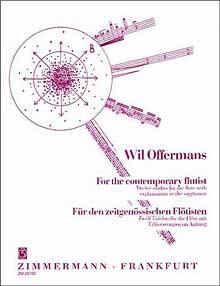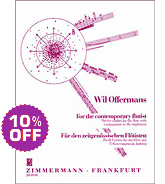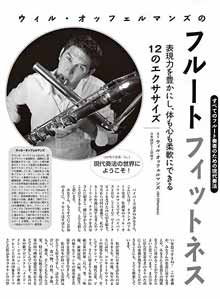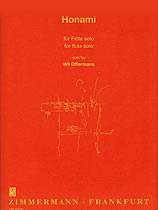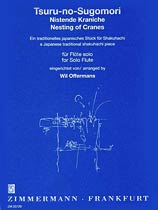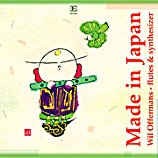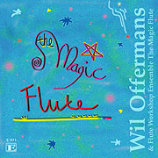Introduction
With this website For the Contemporary Flutist Online, I would like to share extensive thoughts, information, exercises and background stories related to the etude book For the Contemporary Flutist and to the extended flute techniques in general. The etude book consists of twelve etudes and each etude has its focus on a different extended flute techniques, sometimes also called 'new', 'modern' or 'contemporary' techniques. The book has been awarded by the Newly Published Music Committee of the National Flute Association, USA. Since 1992 the etude book has also been the main material for the Flute Summer Course, an annual course in southern Spain, with participants from all over the world. The solo CD Daily Sensibilities, re-released in 2011, has the etudes performed by the composer himself.
The idea to create this website has been inspired by a request of the Japanese music magazine Pipers in the early spring of 2011, inviting me to write a monthly article related to my etude book For the Contemporary Flutist (for Japanese readers: back numbers Pipers-magazines #356 - #367 with the original articles in Japanese can be ordered here). After finishing these twelve articles, I thought to make them available as a free accessible online source for all flutists with some additional audio/video materials. I hope you will enjoy this website and maybe you will find some useful ideas for your flute playing and enjoyment with your instrument.
 Use the Menu navigation at the top to browse to the different topics. With most topics you will find a video introducing a technique and an etude from For the Contemporary Flutist or check out the general Video Page. Also, don't forget to listen to the many unique sound samples available throughout this site.
Use the Menu navigation at the top to browse to the different topics. With most topics you will find a video introducing a technique and an etude from For the Contemporary Flutist or check out the general Video Page. Also, don't forget to listen to the many unique sound samples available throughout this site.
I try to dedicate as much time and efforts as possible to keep this website updated, running well and free accessible for all. If you ever want to reward and support forthecontemporaryflutist.com, please consider making a donation of any amount. All donations are highly appreciated! Finally, thanks for visiting, please come back often and I hope you will find some interesting and useful materials for your flute playing. Now, let's enjoy music!"
Why Extended Techniques?
It seems a common misunderstanding that extended techniques are supposed to be only useful for playing modern music or for adding some special 'effects' to your playing. However on this website we will talk about the extended techniques as a collection of some most exciting and successful modern tools to develop especially the 'body-part' of our flute playing.
In a simplified image we can split our 'instrument' - the flute-playing - into two parts. The first part is the flute-part, the exterior, the finger-movements. The second part is the body-part, the interior, which includes the breathing, the sound quality, the flexibility, the overall body control and our music enjoyment. Certainly the second part is more difficult to develop, since it involves countless invisible processes. However extended techniques use the sound as an interactive messenger, so that we will learn to understand about the body-part.
Think about extended techniques like a modern tool, similar like we enjoy a mobile phone, the subway or the internet. You don't need to be specifically interested in such items, but to use them can be most constructive and effective. In a similar way, we can all benefit from studying extended techniques. In the end it is all about the sound, control and enjoyment.
The Traditional Circle
In the circle-image below you see a imaginary overview of all kinds of flute techniques, each indicated by a simple dot. We locate the more common playing techniques in the centre. For example, playing a mf-note in the middle range of the flute might be located in the very centre of this image. More remote from the centre we may locate less common techniques, e.g. a pp-sound in the top register, or a ff-double staccato in the low register of the flute. In this way we can locate all playing techniques in this circle. Where exactly which technique will be located will be a personal choice since each flutist is different (a Balinese suling-player will probably place the circular breathing in the very centre!).
When studying, we often seem to work mainly with the techniques in the very centre. This means that we primarily study the subjects which we already master. For example, we use the centre-techniques in the morning for our warming-up, but also later in the day in the repertoire studies (the majority of the flute literature is about mf-sounds in the middle range of the flute). So when do we leave the centre and start to study the problems? It seems that we at first want to study the more 'secure' middle range, and only later in the day we allow ourselves to try to tackle the more 'problematic' techniques. Or even worse! Often a day passes quickly since we are all busy people, and at the end of the day we think: "OK, tomorrow I am going to work on the problem…".
To speak a little in black and white: we mainly study what we already master while we postpone the difficulties and the problems until 'tomorrow'. We repeat and repeat that what we already can, reconfirming our 'good' qualities (and our 'bad' ones). We teach ourselves what is 'easy' and what is 'difficult' (or what is 'normal' and what is not). With our study we think to strengthen the centre, but in reality we develop a hard and stiff centre area, while losing flexibility. We are building a wall around ourselves. Inside we feel warm and safe, but outside this wall we are afraid and unsure. We tend to search for the secure centre area while telling ourselves: "Tomorrow I will study the problem. Tomorrow…".
The Extended Circle
If we want to study effectively and to upgrade our playing, we should spent most of our time outside the safe central area. It is outside the centre where we can learn to deal with a problem. It is outside the centre that we can progress and it is outside this centre that we can extend our musical qualities. When moving away from the centre, we will encounter lots of 'difficult' and interesting techniques. Here we arrive in an outer circle where we can meet the ppp-sounds, which one moment transfer into a whisper tone; the circular breathing; the sound of wind; the multi-phonic and so on. It is here that we can encounter the wonderful world of extended techniques.

Flexibility, Enjoyment and 'How to use your Body'
To develop the very centre of the circle, we actually should also study the techniques in the remote areas, knowing that we can return to our centre any moment. This also seems quite natural and similar to how we behave in the daily life, where any stand-still can be regarded as a degradation. We want to move, we want to meet with other people (outside circle), so that we can learn about ourselves (centre). We want to meet other cultures (outside) so that we can learn more about our own culture (centre). We want to go on holiday, to leave our work, so that when we will return we will be sharp and fresh again. If we stay too long in one position the body is getting stiff. We strive for flexibility both physically and mentally and moving around in the circle can help us tremendously.
We all know the problem when playing the flute: we can get stiff, in the embouchure, in the shoulders, in the breathing and in the feeling. Here, extended techniques make you learn to be a more relaxed player, with more flexibility in sound and expression. A player with much more enjoyment for yourself and for listeners. There are three important topics which we will encounter when entering the outer circle of extended techniques and which we will frequently refer to when discussing the various extended techniques and etudes (click 'Extended Technique' in the circle image above):
- How to use your body?
- Flexibility
- Enjoyment
The 'Centre'
To summarise: to develop the centre area of our playing we first move away from the centre into the outer circle. There we study the modern tool of extended techniques. Once we return to the centre, we will see that our centre has grown towards more stable and more flexible. Obviously, the exact interpretation of 'centre' might differ for every flutist. Like the word 'normal' has a different meaning for each of us. But, like in the daily life, if we declare our 'normal' as the only law on earth, we actually are building a wall and isolating ourselves from 'the rest'. However if we can express our 'normal' while accepting and experiencing the 'abnormal', we will develop towards more flexible and more relaxed.
From 'RoundAbout 12.5' to 'For the Contemporary Flutist'
Throughout this website I will refer to various flutes, especially ethnic flutes. To give some more background info about how I collected these informations as well as to tell how I came to wrote the etude book For the Contemporary Flutist, I will here introduce the project RoundAbout 12.5.
The project RoundAbout was a 7-month world-wide flute performance (1985-1986), which started with a solo recital at De IJsbreker in Amsterdam. Immediately after this concert I started a travel around the world to 18 countries - or better to say 18 flute cultures - which included Egypt, Indonesia, China, Japan and Colombia. During the travel I researched anything related to the flute, made recordings for the Dutch VPRO-radio, wrote for newspapers and presented concerts with many local musicians in the various countries. The project was sponsored by De IJsbreker, Amsterdam; Musica 85; Gaudeamus; Prins Bernhard Fund; Royal Tropical Institute; VPRO radio; The Hague Municipal Museum; City of Amsterdam; Corps de Garde; Vinke & Co and Pentax Netherlands.

After 7 months, directly after returning to Amsterdam I went straight ahead to the very same stage De IJsbreker (Amsterdam) to present my final concert. Of course, because of the experiences of 7 months travelling, my flute-music went through a huge metamorphose. All together the project was an amazing way to experience the world as well as the flute around the world. Often people asked me what was the most important experience of this project. My answer is clear: I learned that modern flute techniques are not 'new'. Bamboo tones, wind tones, circular breathings, etc, all the ‘modern’ techniques turned out to be in reality most antique techniques, practiced for sometimes thousands of years on all kinds of 'primitive' flutes. This was amazing and a great surprise. While generally regarded as ‘new’ in the western flute-world, these playing styles have been practiced for a really long time on flutes like the shakuhachi, the suling, the klui and many more…
(1985-1986)
The Etude Book 'For the Contemporary Flutist'
After RoundAbout 12.5, I was probably really full of information and I felt a strong need to share this information and make it available to all flutists by writing some flute compositions. Here it was very clear that I did not wanted to write some exclusive new music, but rather something comprehensible and with an accent on enjoyment and body relaxation and development. The final result of this plan was my etude book For the Contemporary Flutist, which I could realise thanks to the support of Rien de Reede and the funding by the Foundation of the Amsterdam Foundation of the Arts. In 1992 the book was published by Zimmermann, Frankfurt (English/German version) and later also by Sejong Publishers Seoul (Korean version) and Zen-on Tokyo (Japanese version).
The LP 'RoundAbout 12.5'
An LP with the title Round About 12.5 has been released in 1986 on the label Attacca Records, Amsterdam by Sieuwert Verster. The LP is a kind of compact audio-report of the RoundAbout 12.5 project, and contains a mixture of recording from the starting concert in De IJsbreker, from during the travel as well as from the final concert after returning the Amsterdam. More information on the LP can be found here.

